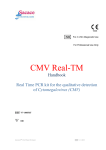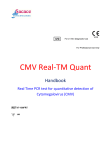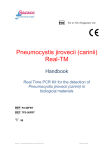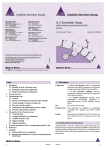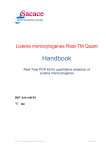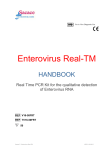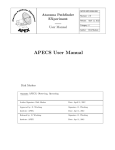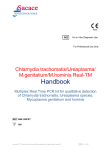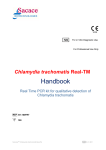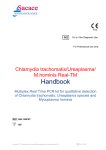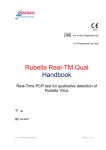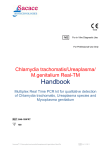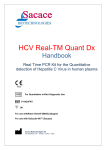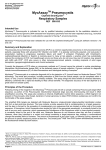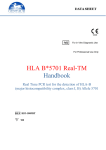Download CMV EBV HHV6 Quant Real TM CE
Transcript
For in Vitro Diagnostic Use
For Professional Use Only
CMV/EBV/HHV6 Quant Real-TM
Handbook
Multiplex Real Time PCR Kit for quantitative detection and
differentiation of Cytomegalovirus (CMV), Epstein Barr Virus (EBV)
and Human Herpes 6 Virus (HHV6)
REF V48-100FRT
100
Sacace™ CMV/EBV/HHV6 Quant Real-TM
VER 10.11.11
NAME
CMV/EBV/HHV6 Quant Real - TM
INTENDED USE
The CMV/EBV/HHV6 Quant Real-TM is a “Real-Time Amplification” test for the quantitative detection and
differentiation of Cytomegalovirus (CMV), Epstein Barr Virus (EBV) and Human Herpes 6 Virus (HHV6) in the
biological materials. DNA is extracted from samples, amplified using real time amplification with fluorescent
reporter dye probes specific for CMV/EBV/HHV6 and Internal Control (IC). Test contains an IC (β-globine gene)
which allows controlling both PCR-analysis stages (DNA extraction and PCR amplification), material sampling, and
storage conditions.
PRINCIPLE OF PCR DETECTION
CMV, EBV and HHV6 detection by polymerase chain reaction (PCR) with hybridization-fluorescence detection
includes DNA extraction from clinical samples and PCR amplification of pathogen genome specific region with
real-time hybridization-fluorescence detection. During DNA extraction from clinical material, human genomic DNA
(endogenous internal control) is amplified. Endogenous internal control (IC Glob) allows controlling both PCRanalysis stages (DNA extraction and PCR amplification), material sampling, and storage adequacy. Then, the
obtained samples are amplified using specific primers and polymerase (TaqF). In real-time PCR, the amplified
product is detected using fluorescent dyes. These dyes are linked to oligonucleotide probes which bind specifically
to the amplified product during thermocycling. The real-time monitoring of the fluorescence intensities during the
real-time PCR allows the detection of accumulating product without re-opening the reaction tubes after the PCR run.
MATERIALS PROVIDED
Reagent
Description
Volume, ml
Quantity
PCR-mix-1-FRT EBV / CMV / HHV-6 / Glob
colorless clear liquid
0.6
2 tubes
PCR-mix-2-FRT
colorless clear liquid
0.3
2 tubes
Polymerase (TaqF)
colorless clear liquid
0.03
2 tubes
RNA-buffer
colorless clear liquid
0.6
1 tube
DNA calibrator КSG1
colorless clear liquid
0.2
1 tube
DNA calibrator КSG2
colorless clear liquid
0.2
1 tube
Negative Control (C-)*
colorless clear liquid
1.2
2 tubes
Positive Control DNA EBV / CMV / HHV-6 and human DNA**
colorless clear liquid
0.1
2 tubes
* must be used in the extraction procedure as Negative Control of Extraction.
** must be used in the extraction procedure as Positive Control of Extraction (PCE).
MATERIALS REQUIRED BUT NOT PROVIDED
• DNA extraction kit.
• Disposable powder-free gloves and laboratory coat.
• Automated pipettors (dosers) of variable volumes (from 5 to 20 µl and from 20 to 200 µl).
• Disposable tips with aerosol barriers (100 or 200 µl) in tube racks.
• Tube racks
• Vortex mixer/desktop centrifuge.
• PCR box.
• Personal thermocyclers (for example, Rotor-Gene 3000 or Rotor-Gene 6000 (Corbett Research,); Rotor-Gene Q
(Qiagen) iQ5 and iCycler iQ (Bio-Rad), Mx3000P (Stratagene) or equivalent).
• Disposable polypropylene microtubes for PCR or PCR-plate.
• Refrigerator for 2–8 °C.
• Deep-freezer for ≤ –16 °C.
• Waste bin for used tips.
Sacace™ CMV/EBV/HHV6 Quant Real-TM
VER 10.11.11
STORAGE INSTRUCTIONS
All components of the CMV/EBV/HHV6 Quant Real-TM PCR kit (except for PCR-mix-1-FRT EBV / CMV / HHV-6
/ Glob, PCR-mix-2-FRT, and Polymerase (TaqF)) are to be stored at 2–8 ºC when not in use.
The kit can be shipped at 2-8°C but should be stored -20°C immediately on receipt.
The shelf life of reagents before and after the first use is the same, unless otherwise stated.
STABILITY
CMV/EBV/HHV6 Quant Real-TM Test is stable up to the expiration date indicated on the kit label. The product
will maintain performance through the control date printed on the label. Exposure to light, heat or humidity may
affect the shelf life of some of the kit components and should be avoided. Repeated thawing and freezing of these
reagents should be avoided, as this may reduce the sensitivity. Components stored under conditions other than those
stated on the labels may not perform properly and may adversely affect the assay results.
WARNINGS AND PRECAUTIONS
In Vitro Diagnostic Medical Device
For In Vitro Diagnostic Use Only
1.
Wear disposable gloves, laboratory coats and eye protection when handling specimens and reagents.
Thoroughly wash hands afterward.
2. Do not pipette by mouth.
3. Do not eat, drink, smoke, apply cosmetics, or handle contact lenses in laboratory work areas.
4. Do not use a kit after its expiration date.
5. Dispose of all specimens and unused reagents in accordance with local regulations.
6. Biosafety Level 2 should be used for materials that contain or are suspected of containing infectious agents.
7. Clean and disinfect all spills of specimens or reagents using a disinfectant such as 0,5% sodium hypochlorite, or
other suitable disinfectant.
8. Avoid contact of specimens and reagents with the skin, eyes and mucous membranes. If these solutions come
into contact, rinse immediately with water and seek medical advice immediately.
9. Material Safety Data Sheets (MSDS) are available on request.
10. Use of this product should be limited to personnel trained in the techniques of DNA amplification.
11. PCR reactions are sensitive to contamination. Measures to reduce the risk of contamination in the laboratory
include physically separating the activities involved in performing PCR in compliance with good laboratory
practice.
12. Workflow in the laboratory must proceed in a uni-directional manner, beginning in the Extraction Area and
moving to the Amplification and Detection Area. Do not return samples, equipment and reagents in the area
where you performed previous step.
Some components of this kit contain sodium azide as a preservative. Do not use metal tubing for reagent
transfer.
PRODUCT USE LIMITATIONS
All reagents may exclusively be used in in vitro diagnostics. Use of this product should be limited to personnel
trained in the techniques of DNA amplification (EN375). Strict compliance with the user manual is required for
optimal PCR results. Attention should be paid to expiration dates printed on the box and labels of all components.
Do not use a kit after its expiration date.
QUALITY CONTROL
In accordance with Sacace’s ISO 13485-Certified Quality Management System, each lot is tested against
predetermined specifications to ensure consistent product quality.
SAMPLE COLLECTION, STORAGE AND TRANSPORT
CMV/EBV/HHV6 Quant Real-TM can analyze DNA extracted from:
•
whole peripheral and umbilical cord blood collected in either ACD or EDTA tubes;
•
buffy coat;
•
tissue homogenized with mechanical homogenizer and dissolved in PBS sterile;
•
urine (sediment);
•
swabs: insert the swab into the nuclease-free 1,5 ml tube and add 0,2 mL of Transport medium. Vigorously
agitate swabs in medium for 15-20 sec.
It is recommended to process samples immediately after collection. Store samples at 2–8 °C for no longer than 24
hours, or freeze at –20/80°C. Transportation of clinical specimens must comply with country, federal, state and
local regulations for the transport of etiologic agents.
Sacace™ CMV/EBV/HHV6 Quant Real-TM
VER 10.11.11
DNA ISOLATION
The following isolation kit is recommended:
⇒ DNA-Sorb-B (Sacace, REF K-1-1/B)
⇒ DNA/RNA-Prep (Sacace, REF K-2-9)
Extract DNA according to the manufacturer’s instructions.
Transfer 100 µl of Negative Control to the tube labeled C–. Transfer 90 µl of Negative Control and
10 µl of Positive Control DNA EBV / CMV / HHV-6 and human DNA to the tube labeled PCE.
PROTOCOL (Reaction volume 25 µl):
1. Prepare in the new sterile tube for each sample 10*N µl of PCR-mix-1 “CMV/EBV/HHV6/IC”, 5,0*N of
PCR-Buffer-FRT and 0,5*N of TaqF DNA Polymerase. Vortex and centrifuge for 2-3 sec.
2. Prepare required quantity of reaction tubes for samples and controls and add 15 µl of Reaction Mix and 10 µl
of extracted DNA sample to appropriate tube. Mix by pipetting.
(Re-centrifuge all the tubes with extracted DNA for 2 min at maximum speed (12000-16000 g) and take carefully
supernatant. N.B. don’t disturb the pellet, sorbent inhibit reaction!).
3. For qualitative analysis:
- Add 10 µl of RNA-buffer to the tube labeled NCA (Negative Control of Amplification).
NCA
- Add 10 µl of DNA calibrator КSG2 to the tube labeled C+ (Positive Control of Amplification).
C+
4. For quantitative analysis:
- Add 10 µl of RNA-buffer to the tube labeled NCA (Negative Control of Amplification).
NCA
Calibrators
- Add 10 µl of КSG1 to two tubes and add 10 µl of КSG2 to other two tubes
КSG1 and КSG2
Close tubes and transfer them into the instrument in this order: samples, negative controls, positive control,
Standards.
Amplification program for rotor-type instruments1
Step
Тemperature, °С
Time
Fluorescence detection
Cycles
Hold
95
15 min
–
1
Cycling 1
Cycling 2
95
5s
–
60
20 s
–
72
15 s
–
95
5s
60
20 s
72
15 s
–
FAM/Green, JOE/Yellow, ROX/Orange,
Cy5/Red
–
5
40
Amplification program for plate-type and modular type instruments2
Step
Тemperature, °С
Time
Fluorescence detection
Cycles
1
95
15 min
–
1
2
3
95
5s
–
60
20 s
–
72
15 s
–
95
5s
60
30 s
72
15 s
–
FAM, JOE/HEX/Cy3,
ROX/TexasRed, Cy5
–
5
40
1
For example Rotor-Gene™ 6000/Q (Qiagen)
For example, iQ5™ (BioRad); Mx3005P™ (Agilent Technologies), ABI® 7500 Real Time PCR (Applied
Biosystems), SmartCycler® (Cepheid)
2
Sacace™ CMV/EBV/HHV6 Quant Real-TM
VER 10.11.11
RESULTS ANALYSIS
β-Globin gene DNA (IC) is detected in the FAM/Green channel, EBV DNA is detected in the
JOE/HEX/Cy3/Yellow channel, CMV DNA is detected in the ROX/TexasRed/Orange channel, and HHV6 DNA is
detected in the Cy5/Red channel.
Interpretation of results
The results are interpreted by the software of the used Instrument by the crossing (or not) of the fluorescence curve
with the threshold line.
1. The sample is considered to be positive for EBV DNA if its Ct value in the results grid on the
JOE/HEX/Cy3/Yellow channel is detected and does not exceed the threshold value of positive result.
2. The sample is considered to be positive for CMV DNA if its Ct value in the results grid on the
ROX/Orange/TexasRed channel is defined and does not exceed the threshold value of positive result.
3. The sample is considered to be positive for HHV6 DNA if its Ct value in the results grid on the Cy5/Red
channel is defined and does not exceed the threshold value of positive result.
4. For qualitative analysis, the sample is considered to be negative if its Ct value in the results grid in the
FAM/Green channel does not exceed the Ct value indicated in the Product Data Sheet.
5. For quantitative analysis, the quantity of IC Glob DNA should be greater than 2000 copies per reaction for
whole blood, white blood cells, viscera biopsy material or more than 500 copies per reaction for saliva and
oropharyngeal swabs.
For cerebrospinal fluid (liquor), the Ct value can be greater than the Ct value indicated in the Product Data Card
in the results grid in the FAM/Green channel or the quantity of IC Glob DNA can be less than 500 copies per
reaction in case of quantitative analysis because the cerebrospinal fluid samples may contain a very small number
of cells.
6. For qualitative analysis, the result of analysis is considered to be invalid if the Ct value is not detected in the
results grid (the fluorescence curve does not cross the threshold line) or if it is greater than the threshold value in
the JOE/HEX/Yellow, ROX/Orange, or Cy5/Red channel and the Ct value in the results grid in the FAM/Green
channel exceeds the Ct value indicated in the Product Data Sheet.
7. For quantitative analysis, the analysis result is considered to be invalid if the Ct value is not detected in the
results grid (the fluorescence curve does not cross the threshold line) or if it is greater than the boundary value
in the JOE/Yellow/HEX, ROX/Orange, or Cy5/Red channel and the quantity of IC Glob DNA is less than 2000
copies per reaction for whole blood, white blood cells, viscera biopsy material or if it is less than 500 copies per
reaction for saliva and oropharyngeal swabs. In such cases, PCR analysis of the sample should be repeated.
8.
For qualitative analysis, results of analysis are considered reliable only if the results obtained for both Positive
and Negative Controls of amplification as well as for the Negative Control of extraction are correct. For
quantitative analysis, results on C+ should fall in range of concentrations indicated in the Product Data Sheet.
Table. 1. Results for controls
Ct in channel
Control
Stage for control
DNA extraction, PCR
PCR
Neg
Neg
JOE/HEX/
Cy3/Yellow
Neg
Neg
C+
PCR
POS
POS
QS1
QS2
PCR
Pos
(see Data Sheet)
Pos
(see Data Sheet)
FAM/Green
NCE
NCA
Sacace™ CMV/EBV/HHV6 Quant Real-TM
ROX/Orange/
TexasRed
Neg
Neg
Interpretation
Cy5/Red
Neg
Neg
OK
OK
POS
POS
OK
Pos
(see Data Sheet)
Pos
(see Data Sheet)
OK
VER 10.11.11
Quantitative results
In quantitative analysis, if total DNA is extracted from human whole blood, white blood cells and biopsy
material, the concentration in log of DNA copies per standard cell quantity (105) in control and test samples is
calculated by the following formula:
For CMV:
log { CMV DNA copies in PCR sample x 2*105}= log {CMV DNA copies/105 of cells}.
Glob DNA copies in PCR sample
For EBV:
log { EBV DNA copies in PCR sample x 2*105}= log { EBV DNA copies/105 of cells}.
Glob DNA copies in PCR sample
For HHV6:
log { HHV6 DNA copies in PCR sample x 2*105}= log { HHV6 DNA copies/105 of cells}.
Glob DNA copies in PCR sample
The results can be calculated manually or using Excel tables. To do this copy the names of the samples and insert
them in the first column (Column A). Copy the concentrations of EBV DNA from the channel
Joe(Yellow)/HEX/Cy3 and paste in the second column of Excel table (Column B). Copy the concentrations of IC
Glob from the channel Fam(Green) and paste in the third column of Excel table (Column C). Insert in the column D
the formula D=LOG (B/C*200000): log values will appear.
Name
A
1
2
3
4
5
QS1
QS1
QS2
QS2
Neg PCR
Calc Conc
(copies/reaction)
Joe(Yellow)/HEX/Cy3
Calc Conc
(copies/reaction)
Fam(Green)
B
8742
253
C
125640
87787
65765
16354
76865
9793
10143
103
97
648
9962
10011
98
102
log EBV/105 cells
D
4,1
2,8
3,9
Use the same procedure for calculation of CMV (ROX/Orange/TexasRed channel) and HHV6 (Cy5/Red channel)
log quantity inserting in the column B the relative results.
If total DNA is extracted from saliva, oropharyngeal swabs and cerebrospinal fluid (liquor), the concentration of
DNA per ml of sample (Conc DNA) is calculated by the following formula:
Conc DNA = C DNA х 100 (copies/ml)
C DNA is the number of EBV DNA copies, or the number of CMV DNA copies, or the number of HHV6 DNA
copies in DNA sample.
Sacace™ CMV/EBV/HHV6 Quant Real-TM
VER 10.11.11
Table 2. Example of Qualitative Analysis
Ct limits
No.
Desription
IC
EBV
CMV
HHV6
28
35
35
35
Joe
(EBV)
Rox
(CMV)
Cy5 (HHV6)
Ct
Ct
Ct
34,12
27,7
Fam
(IC)
Name
Ct
1
344
27,18
2
445
26,41
3
451
29,81
4
456
23,3
28,48
Result
EBV
CMV
HHV6
28
HHV6
-
-
+
32,1
CMV, HHV6
-
+
+
Invalid
?
?
?
EBV, HHV6
+
-
+
Invalid-?,
(low CMV)
?
low
?
EBV
+
-
-
+
-
+
+
5
461
29,02
6
472
24,83
33,28
7
477
17,51
24,06
34,95
EBV, HHV6
8
489
21,32
21,85
27,2
EBV, HHV6
+
-
9
491
23,47
28,15
EBV
+
-
-
10
494
29,88
Invalid
?
?
?
11
497
16,29
EBV, HHV6
12
501
18,5
+
-
+
+
-
13
C+
27,23
30,18
28,47
27,25
OK
14
C+
26,06
30,45
27,95
26,58
OK
15
C+
26,37
30,8
28,17
26,73
16
C- (Neg. Control)
OK
17
C- (DNA-buffer)
OK
18
C- (DNA-buffer)
OK
35,08
31,06
34,18
32,64
CMV
OK
QUALITY CONTROL PROCEDURE
CMV/EBV/HHV6 Quant Real-TM PCR contains the Internal Control IC (human beta-globine gene), which
allows to control the presence of cellular material in the sample. If the sample is not correctly prepared or it is an
insufficient quantity of epithelial cells the Internal Control will not be detected.
A negative control of extraction (NCE), negative amplification control (NCA), positive amplification control (C+)
are required for every run to verify that the specimen preparation, the amplification and the detection steps are
performed correctly.
If the controls are out of their expected range (see table Results for Controls), all of the specimens and controls from
that run must be processed beginning from the sample preparation step.
TROUBLESHOOTING
Results of analysis are not taken into account in the following cases:
1. The presence of any Ct value on JOE/Yellow/HEX, FAM/Green, ROX/Orange and Cy5/Red channels in the
results grid for the Negative Control of Amplification (NCA) and for the Neg. Control of Extraction (C-)
indicates contamination of reagents or samples. In this case, PCR analysis should be repeated for all samples in
which pathogen DNA was detected starting from the DNA extraction stage.
2. For qualitative analysis, if the Ct value in the results grid for the Positive Control of PCR on the
JOE/Yellow/HEX, FAM/Green, ROX/Orange, or Cy5/Red channels is absent, it is necessary to repeat
amplification for all samples where pathogen DNA was not detected.
3. If the Ct value for the sample is not detected on JOE/Yellow/HEX/Cy3, ROX/Orange/TexasRed, Cy5/Red
channel or it exceeds the boundary Ct value specified in the Data Sheet and the Ct value for the sample is
greater than the maximum Ct value for IC in the FAM/Green channel, analysis should be repeated starting from
the DNA extraction stage. This error may be caused by incorrect treatment of clinical material, which resulted in
the loss of DNA, or by the presence of PCR inhibitors.
4. If the Ct value for the sample is detected in JOE/Yellow/HEX/Cy3, ROX/Orange/TexasRed or Cy5/Red
channel and it is greater than the boundary Ct value specified in the Data Sheet, the result is considered to be
equivocal. It is necessary to repeat analysis of such sample in duplicate. If a reproducible positive Ct value is
obtained, the result is considered to be positive; otherwise, the result is considered to be equivocal.
Sacace™ CMV/EBV/HHV6 Quant Real-TM
VER 10.11.11
PERFORMANCE CHARACTERISTICS
Sensitivity
The analytical sensitivity of CMV/EBV/HHV6 Quant Real-TM PCR kit is specified in the table below.
Nucleic acid extraction
kit
Sensitivity
Cerebrospinal fluid (liquor), saliva,
oropharyngeal swabs, and lavages
DNA/RNA-Prep
400 copies/ml
Whole human blood, white blood cells,
viscera biopsy material
DNA/RNA-Prep
5 DNA copies
per 105 cells
Type of clinical material
Specificity
CMV/EBV/HHV6 Quant Real-TM PCR kit is intended for Epstein-Barr virus (EBV) DNA, Human Herpes Virus
type 6 (HHV6) DNA and human cytomegalovirus (CMV) DNA detection. Specific activity of CMV/EBV/HHV6
Quant Real-TM PCR kit was confirmed by analysis of reference CMV strain AD 169, QCMD panel for EpsteinBarr virus, as well as by analysis of clinical material with subsequent confirmation of results by sequencing the
amplified fragments. The activity of the PCR kit components with respect to DNA of other viruses (herpes simplex
virus types 1 and 2, human herpes virus type 8, Varicella Zoster Virus, Parvovirus B19, and others), bacterial
pathogens (Staphylococcus aureus, Streptococcus pyogenes, Streptococcus agalactiae, and others) and human DNA
was absent. The clinical specificity of CMV/EBV/HHV6 Quant Real-TM PCR kit was confirmed in laboratory
clinical trials.
Target region: CMV – MIE, EBV – LMP, HHV6 – pol gene
REFERENCES
•
PCR detection of cytomegalovirus DNA in serum as a diagnostic test for congenital cytomegalovirus
infection. C T Nelson, A S Istas, M K Wilkerson, and G J Demmler. J Clin Microbiol. 1995 December;
33(12): 3317–3318.
•
Detection of Cytomegalovirus DNA in Peripheral Blood of Patients Infected with Human
Immunodeficiency Virus. D. Shibata, W. John Martin, Maria D. Appleman, Dennis M. Causey, J. M.
Leedom, N. Arnheim. J Infect Dis. (1988) 158 (6): 1185-1192.
•
Multiplex PCR for six herpesviruses after hematopoietic stem cell transplantation. Sawada A, Koyama-Sato
M, Yasui M, Kondo O, Ishihara T, Takeshita Y, Okamura T, Nishikawa M, Inoue M, Kawa Pediatr Int.
2011 Aug 2. doi: 10.1111/j.1442-200X.2011.03437.
•
Cytomegalovirus Infections in Non-immunocompromised and Immunocompromised Patients in the
Intensive Care Unit. Florescu DF, Kalil AC. Infect Disord Drug Targets. 2011 Jun 16.
•
Comparison of PCR, Antigenemia Assay, and Rapid Blood Culture for Detection and Prevention of
Cytomegalovirus Disease after Lung Transplantation. Adriana Weinberg, Tony N. Hodges, Shaobing Li,
Guanyung Cai, M. R. Zamora. Journal of Clinical Microbiology, February 2000, p. 768-772, Vol. 38, No. 2
•
Optimization of Quantitative Detection of Cytomegalovirus DNA in Plasma by Real-Time PCR. Michael
Boeckh, MeeiLi Huang, James Ferrenberg, Terry Stevens-Ayers, Laurence Stensland, W. Garrett Nichols,
and Lawrence Corey. Journal of Clinical Microbiology, March 2004, p. 1142-1148, Vol. 42, No. 3
•
Quantification of Human Cytomegalovirus DNA by Real-Time PCR. Elyanne Gault,Yanne Michel, Axelle
Dehée, Chahrazed Belabani, Jean-Claude Nicolas, Antoine Garbarg-Chenon. J Clin Microbiol. 2001
February; 39(2): 772–775
•
Definitions of Cytomegalovirus Infection and Disease in Transplant Recipients. Per Ljungman, Paul
Griffiths, Carlos Paya, …Clin Infect Dis. (2002) 34 (8): 1094-1097
Sacace™ CMV/EBV/HHV6 Quant Real-TM
VER 10.11.11
KEY TO SYMBOLS USED
List Number
Caution!
Lot Number
Contains sufficient
for <n> tests
For in Vitro Diagnostic Use
Version
Store at
NCA
Negative Control of
Amplification
Manufacturer
C–
Negative control of
Extraction
Consult instructions for use
C+
Positive Control of
Amplification
Expiration Date
IC
Internal Control
*iQ5™ is a registered trademark of Bio-Rad Laboratories
* Rotor-Gene™ Technology is a registered trademark of Qiagene
* MX3005P® is a registered trademark of Agilent Technologies
*ABI® is a registered trademark of Applied Biosystems
* SmartCycler® is a registered trademark of Cepheid
Sacace™ CMV/EBV/HHV6 Quant Real-TM
VER 10.11.11
NOTE
Sacace™ CMV/EBV/HHV6 Quant Real-TM
VER 10.11.11
Sacace™ CMV/EBV/HHV6 Quant Real-TM
VER 10.11.11
Sacace Biotechnologies Srl
via Scalabrini, 44 – 22100 – Como – Italy Tel +390314892927 Fax +390314892926
mail: [email protected] web: www.sacace.com
Sacace™ CMV/EBV/HHV6 Quant Real-TM
VER 10.11.11












